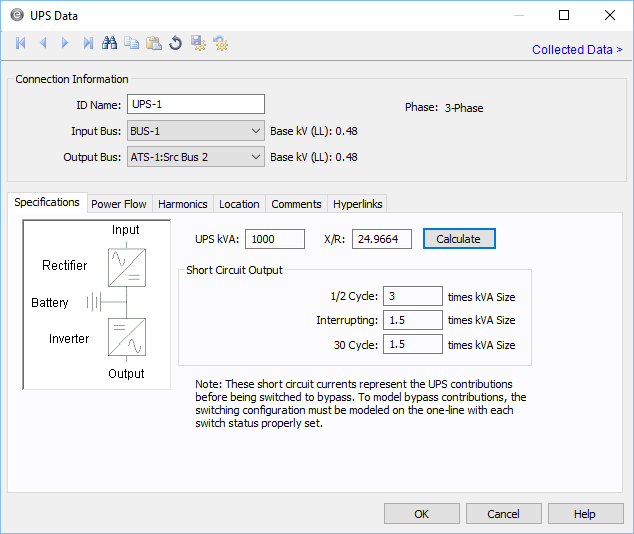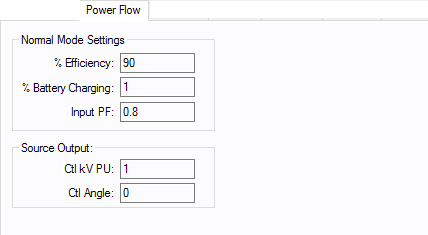UPS Data
This dialog box includes the following areas and tabs:
See Common Tabs for information on the Location, Reliability, Comments, Hyperlinks, Media Gallery, or Collected Data tabs.

Figure 1: UPS Data Dialog Box

Figure 2: UPS Short Circuit Output Settings for IEC
Connection Information
Specifications Tab
| Option | Description |
|---|---|
| UPS kVA | kVA rating of the UPS. |
| X/R | X/R ratio used for short circuit calculations at the output. |
| Short Circuit Output | |
| ½ Cycle / Initial |
The value is entered as a multiple of the kVA rating. Example: A 500kVA/0.48kV UPS has a momentary short circuit contribution of 3000Amps. The short circuit capability in multiples of kVA rating is 4.988 (~5.0). [ multiple = sqrt(3)*3kA*0.48kV/500kVA.] |
| Interrupting / Breaking |
|
| 30 Cycle / Steady State |
|
Power Flow Tab

Figure 3: UPS Data Power Flow tab
| Option | Description |
|---|---|
| % Efficiency | Efficiency of UPS in delivering active power to load. When there is no battery charging, input active load is equal to output active load divided by efficiency. |
| % Battery Charging | Power consumed in charging battery, expressed as percentage of Rated kVA of UPS. |
| Input PF | Power factor of input. |
| Ctrl kV PU | The per unit output voltage of the UPS, which the UPS tries to maintain. |
| Ctrl Angle | The output voltage angle of the UPS, which the UPS tries to maintain. |
Harmonics Tab
Use the Harmonics tab to indicate whether this equipment item is introducing harmonics into your power system.
Figure 4: Harmonics Tab
| Option | Description | |||||||||||||||||||||
|---|---|---|---|---|---|---|---|---|---|---|---|---|---|---|---|---|---|---|---|---|---|---|
| Load Type |
The default is Linear, indicating the equipment does not produce harmonics. Choosing Harmonic makes the item an harmonic source and makes other fields in this tab available to edit. Note: For an adjustable frequency drive (AFD), the Load Type is always Harmonic. |
|||||||||||||||||||||
| Fundamental Amps |
Use to set the fundamental amps. The options are as follows:
To use fundamental current calculated by power flow, select Calculated from Power Flow in the Summation Fundamental Voltage area of the Harmonics Options > Control dialog box. |
|||||||||||||||||||||
| Harmonic Spreadsheet |
Use the spreadsheet to enter the harmonic spectrum produced by this item. You can enter up to 30 different harmonics in each equipment item. In the spreadsheet, enter the Harmonic Number (such as 5 for the 5th harmonic), the Harmonic Current in percent of the Fundamental Amps, and the Current Angle. By indicating the current angle, you can simulate transformer phase shift effects on rectifiers so appropriate canceling can take place. The harmonic may be integer or non-integer. |
|||||||||||||||||||||
| Library Load |
Common harmonic spectra may be entered from the device library. For instructions on how to enter your own spectra information, see Harmonics with Spectrum™. After selecting a particular device library spectrum from the Mfr and Type lists, click Import, and that spectrum is entered into the harmonic spreadsheet. |
|||||||||||||||||||||
| Resistance Factor |
EasyPower offers two methods for calculating RH:
RH = RFund * H R-EXP RH = RFund * (1+ECF*H2)/(1+ECF) EasyPower defaults all skin effect correction to R-EXP and a value of 0.5.
|
Other Tabs
See Common Tabs for information on the Location, Reliability, Comments, Hyperlinks, Media Gallery, or Collected Data tabs.
More Information
| Database Technical Reference | Common Tabs |
| Media Gallery |

